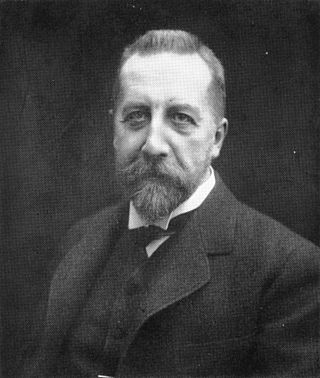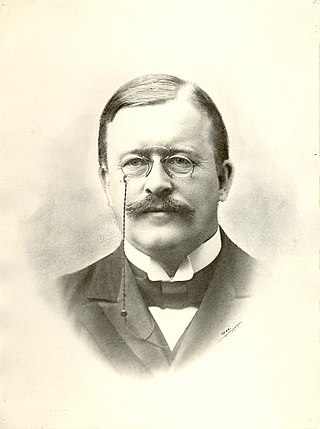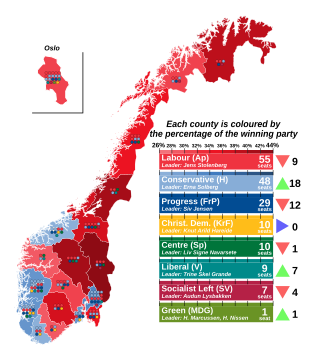Related Research Articles
The politics of Norway take place in the framework of a parliamentary, representative democratic constitutional monarchy. Executive power is exercised by the Council of State, the cabinet, led by the prime minister of Norway. Legislative power is vested in both the government and the legislature, the Storting, elected within a multi-party system. The judiciary is independent of the executive branch and the legislature.

The Moderate Party, commonly referred to as the Moderates, is a liberal-conservative political party in Sweden. The party generally supports tax cuts, the free market, civil liberties and economic liberalism. Internationally, it is a full member of the International Democrat Union and the European People's Party.

Sweden and Norway or Sweden–Norway, officially the United Kingdoms of Sweden and Norway, and known as the United Kingdoms, was a personal union of the separate kingdoms of Sweden and Norway under a common monarch and common foreign policy that lasted from 1814 until its peaceful dissolution in 1905.
A minority government, minority cabinet, minority administration, or a minority parliament is a government and cabinet formed in a parliamentary system when a political party or coalition of parties does not have a majority of overall seats in the legislature. It is sworn into office, with or without the formal support of other parties, enabling a government to be formed. Under such a government, legislation can only be passed with the support or consent of enough other members of the legislature to provide a majority, encouraging multi-partisanship. In bicameral legislatures, the term relates to the situation in the chamber whose confidence is considered most crucial to the continuance in office of the government.
A national unity government, government of national unity (GNU), or national union government is a broad coalition government consisting of all parties in the legislature, usually formed during a time of war or other national emergency. A unity government according to the principles of consensus democracy lacks opposition, or opposition parties are too small and negligible. Switzerland is an example of country with stable, long-term national unity governments.

Peter Christian Hersleb Kjerschow Michelsen, better known as Christian Michelsen, was a Norwegian shipping magnate and statesman. He was the first prime minister of independent Norway and Norway's 9th prime minister from 1905 to 1907. Michelsen is most known for his central role in the dissolution of the union between Norway and Sweden in 1905, and was one of Norway's most influential politicians of his time.
The Conservative Party or The Right is a liberal-conservative political party in Norway. It is the major party of the Norwegian centre-right, and was the leading party in government as part of the Solberg cabinet from 2013 to 2021. The current party leader is former Prime Minister Erna Solberg. The party is a member of the International Democrat Union and an associate member of the European People's Party.

The Liberal Party is a centrist political party in Norway. It was founded in 1884 and it is the oldest political party in Norway. It is positioned in the centre on the political spectrum, and it is a liberal party which has over the time enacted reforms such as parliamentarism, freedom of religion, universal suffrage, and state schooling.

The dissolution of the union between the kingdoms of Norway and Sweden under the House of Bernadotte, was set in motion by a resolution of the Storting on 7 June 1905. Following some months of tension and fear of an outbreak of war between the neighbouring kingdoms – and a Norwegian plebiscite held on 13 August which overwhelmingly backed dissolution – negotiations between the two governments led to Sweden's recognition of Norway as an independent constitutional monarchy on 26 October 1905. On that date, King Oscar II renounced his claim to the Norwegian throne, effectively dissolving the United Kingdoms of Sweden and Norway, and this event was swiftly followed, on 18 November, by the accession to the Norwegian throne of Prince Carl of Denmark, taking the name of Haakon VII.

Johan Castberg was a Norwegian jurist and politician best known for representing the Radical People's Party. He was a government minister from 1908 to 1910 and 1913 to 1914, and also served seven terms in the Norwegian Parliament. The brother-in-law of Katti Anker Møller, the two were responsible for implementing the highly progressive Castberg laws, granting rights to children born out of wedlock. Altogether, he was one of the most influential politicians in the early 20th century Norway.
The Moderate Liberal Party was a political party in Norway that emerged from the moderate and religious branches of the Liberal Party in 1888. The party's turn towards cooperation with the Conservative Party caused a party split in 1891, eventually sharpening its profile as a moderate-conservative party based among the low church of south-western Norway. The party was dissolved shortly after the dissolution of the union with Sweden in 1905.
The Free-minded Liberal Party was a political party in Norway founded in 1909 by the conservative-liberal faction of the Liberal Party. The party cooperated closely with the Conservative Party and participated in several short-lived governments, including two headed by Free-minded Prime Ministers. In the 1930s the party changed its name to the Free-minded People's Party and initiated cooperation with nationalist groups. The party contested its last election in 1936, and was not reorganised in 1945.
In parliamentary politics, balance of power is a situation in which one or more members of a parliamentary or similar chamber can by their uncommitted vote enable a party to attain and remain in minority government. The term may also be applied to the members who hold that position. The members holding the balance of power may guarantee their support for a government by either joining it in a coalition government or by an assurance that they will vote against any motion of no confidence in the government or will abstain in such a vote. In return for such a commitment, such members may demand legislative or policy commitments from the party they are to support. A person or party may also hold a balance of power in a chamber without any commitment to government, in which case both the government and opposition groupings may on occasion need to negotiate for that person's or party's support.

The Michelsen's Cabinet was a Norwegian cabinet, formed by a coalition of the Liberal Party, the Conservative Party, the Moderate Liberal Party and the Coalition Party. It governed Norway between 11 March 1905 and 23 October 1907. It entered office as part of the build-up for the dissolution of the union between Norway and Sweden in 1905. It had the following composition:

Jon Gundersen Hol was a Norwegian engineer and activist. He is known for his pamphlet Rifleringen, published in February 1884, that resulted in his arrest for lèse majesté. In the pamphlet, he called for soldiers and civilians to arm themselves and encircle the Parliament of Norway Building, creating a "Ring of Rifles", should the need arise. The political situation in Norway at the time was unstable, with an ongoing impeachment case against the conservative government started by political liberals. King Oscar II of Sweden and Norway supported the conservative politicians, and Hol believed that a political and military counter-offensive was planned, hence the need for guarding the Parliament. The tensions between liberals and conservatives drew Hol into politics in the first place in 1880. Before this, he was an engineer by occupation and a writer, albeit apolitical. He increased his writing after 1880, and also involved himself in non-socialist trade unions, including the unsuccessful attempt of establishing a national trade union center in Kristiania.

Parliamentary elections were held in Norway on 8 and 9 September 2013 to elect all 169 members of the unicameral Storting. The centre-right coalition obtained 96 seats, while the incumbent red–green coalition government obtained 72 seats and the Green Party obtained one. The Labour Party won the largest share (30.8%) of the votes cast, with the Conservatives coming second (26.8%), after increasing its share by 9.6 percentage points.

Parliamentary elections were held in Norway on 11 September 2017 to elect all 169 members of the unicameral Norwegian Parliament, the Storting. The non-socialist parties retained a reduced majority of 88 seats, allowing Prime Minister Erna Solberg's Conservative-Progress coalition to remain in government. The Liberal Party joined the coalition in January 2018 but it remained a minority cabinet until the Christian Democratic Party joined the coalition in 2019. The three largest centre-left parties won 79 seats. The Green Party retained its single seat, while the Red Party won its first ever seat.
Republicanism in Norway is a movement to replace the constitutional monarchy with a republican form of government. The country has always been ruled by a monarch and has never been a republic. Since 1905 and the dissolution of the union with Sweden several republican movements and thoughts have arisen. Currently, the Norwegian Republican Association is the only non-partisan organisation campaigning to abolish the monarchy and make Norway a republic.
References
- 1 2 3 4 5 Kaartvedt, Alf (1984). Høyres historie 1: Drømmen om borgerlig samling: 1884-1918 (in Norwegian). Cappelen. pp. 196–209. ISBN 8202049903.
- ↑ "Samlingspartiet – norsk politisk sammenslutning" (in Norwegian). 14 February 2009.
- ↑ Leiv Mjeldheim, Den gylne mellomvegen - Tema frå Venstres historie 1905-1940, (Bergen, 2006)
- ↑ "Christian Michelsen's Government 1905 - 1907" at www.stortinget.no (Norwegian parliament website)
- ↑ "Samlingspartiet". Norwegian Social Science Data Services. Archived from the original on 2016-03-05. Retrieved 2015-04-30.